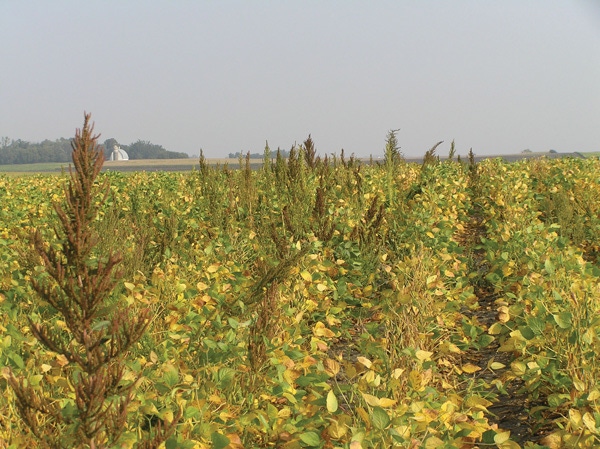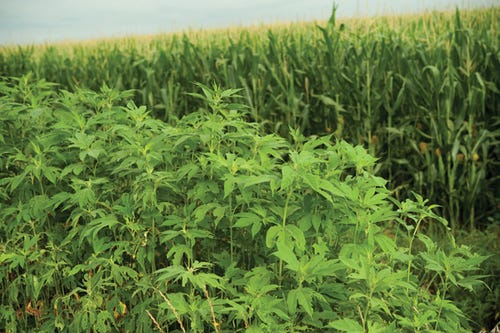January 30, 2012

Weed scientists generally don’t agree on the exact ranking of soybean’s worst weeds, but they mostly agree on which weeds belong in the top four or five that Midwestern soybean growers should be concerned about. Common waterhemp, giant ragweed, marestail (also commonly known as horseweed) and common lambsquarters are listed among the top problematic weeds for soybeans, according to weed experts in Illinois, Iowa, Kentucky and Minnesota. Other yield-robbing culprits in these states include common ragweed, giant foxtail, velvetleaf and annual morningglory.
“In soybeans, common waterhemp can be a huge problem, because of the limited number of postemergence herbicides that will work well on it,” says Aaron Hager, University of Illinois Extension weed scientist. “If you’re planting conventional soybeans, the only postemergence herbicide options for it would be diphenylethers [for example, Flexstar and Cobra]. If you plant LibertyLink soybeans, you can use glufosinate [Liberty], and if you plant Roundup Ready soybeans, you can use glyphosate. However, if you have a weed resistant to both glyphosate and PPO inhibitors, then there’s nothing else you can use postemergence to effectively control it in glyphosate-resistant soybean varieties.”
 As a result, Hager recommends applying a preemergence herbicide with soil residual activity to control common waterhemp in soybeans and then scouting to determine if a postemergence application or inter-row cultivation is needed later. He adds that for corn, there are more products that can be used in a postemergence tankmix that will control common waterhemp, compared to the number of products available for use in soybeans.
As a result, Hager recommends applying a preemergence herbicide with soil residual activity to control common waterhemp in soybeans and then scouting to determine if a postemergence application or inter-row cultivation is needed later. He adds that for corn, there are more products that can be used in a postemergence tankmix that will control common waterhemp, compared to the number of products available for use in soybeans.
Although the top-five worst weeds in Iowa are identical for corn and soybeans, the herbicide choices available are not, notes Mike Owen, Iowa State University (ISU) Extension weed specialist. “You can use different herbicides to control these weeds in corn than you can in soybeans,” he says. “Probably the biggest difference is that you can use 2,4-D and dicamba for corn, but not for soybeans.”
Another commonality among the top worst weeds in Iowa is their resistance to herbicides. “In particular, giant ragweed and common waterhemp populations represent significant resistance to glyphosate in Iowa,” Owen says.
Resistance concerns
Glyphosate resistance has become an increasing worry, not just for common waterhemp control, but for managing other annual weeds like giant and common ragweed, concurs Jeff Gunsolus, University of Minnesota Extension weed scientist. “These weeds are out-crossers, meaning that they pollinate over great distances, which gives them more genetic diversity and makes selection for resistance occur faster,” he says. “That’s particularly true for common waterhemp, which has been confirmed to be herbicide resistant to both glyphosate and ALS inhibitor herbicides in Minnesota and several other Corn Belt states.”
Weed flushes in late summer also make common waterhemp challenging to control, Gunsolus says. “To help control that, you need to have a soybean variety that provides a good canopy to shade out the weeds,” he advises.
Waterhemp shows up along rivers and flood plains in western Kentucky but is not yet widespread across the state, says J. D. Green, University of Kentucky Extension weed scientist.
“In Kentucky, we plant both full-season and double-crop soybeans, and corn/wheat/soybeans is a common crop rotation,” Green notes. “That three-crop rotation has helped us with resistant management up to this point by allowing farmers to rotate different herbicides for each crop.”
Glyphosate resistance has become a problem with marestail, the number-one troublesome weed in Kentucky soybeans, Green says. “As farmers have started their shift to using more glyphosate in corn, the tendency has been to back off the rates for preplant or preemergence corn herbicides, which predisposes more weeds to survive the application,” he says. “Yet famers need to use the full, recommended rates of the soil residual herbicides to get as much benefit from them as possible and not just rely on glyphosate to clean up the mess. A heavy reliance on glyphosate for your main weed control program is only going to lead to problems later.”
Marestail is fairly widespread in no-till systems in Kentucky, Green says. “It’s also glyphosate resistant in many fields scattered across the state,” he adds.
Because marestail seeds are windblown, farmers often have difficulty controlling it after the crop has emerged, Green notes. “So we typically recommend using 2,4-D as part of the burndown program and to include a preplant soil residual herbicide to aid with control,” he adds.
Marestail problems are also common in Illinois, Hager says. “It’s our number-two soybean weed of concern, due mainly to the resistance it has developed to glyphosate, particularly in the southern third of the state,” he says.
“Horseweed/marestail thrives better under a no-till cropping system compared to other tillage systems. So the use of some tillage before planting can be helpful to manage the problem.”
Weed height
When using postemergence herbicides on weeds like marestail and lambsquarters, timing is critical, Hager emphasizes. “Herbicide performance is best if weeds are still small, when using either with a burndown or a timely post application,” he says. “However, sometimes common lambsquarters can be a challenge to control with a postemergence application, depending on environmental conditions.”
Gunsolus agrees. “Common lambsquarters is very sensitive to small weed size for successful postemergence control,” he says. ��“You need to spray lambsquarters while it is still 2 to 3 in. tall. There can also be a lot of environmental barriers for good, postemergence herbicide uptake, such as conditions that are too dry or too cool; it’s a very difficult weed to control solely with postemergence applications.”
Gunsolus recommends using a preemergence herbicide with soil residual chemistry for lambsquarters, waterhemp and ragweed control. “Another reason common lambsquarters is so difficult to manage is the fact that it has a really long life in the seed bank,” he says. “So to reduce the weed seed bank in your fields later in the season, you need to resolve your weed problems early.”
Giant ragweed is also competetive with soybeans, Hager says. “It’s the worst weed for soybean production from an interference standpoint [taking into consideration all negative aspects of weeds growing with crops],” he says. “Switching from conventional tillage to a no-till or to a limited tillage system can help. Other strategies for control include employing an integrated herbicide program that includes a soil residual herbicide at around planting time and timely postemergence applications [at 3- to 4-in. weed heights].”
Fence lines
It’s best to expect that more than one postemergence application will be needed to control giant ragweed, Hager says. “Fence lines tend to harbor giant ragweed that, if left uncontrolled, will continue to provide seed to infest fields,” he says. “So scout 7 to 10 days after an initial postemergence application and look for a second flush of weeds.”
Annual morningglory weeds also can congregate along field borders. “Since farmers typically have more problems with morningglory on the border edges of the field, rather than in the middle of the field, a spot treatment on the outer edges later in the season can be an effective strategy,” Hager says.
Timing is also extremely important with annual morningglory control, Green notes. “It can get away from you very quickly,” he says. “Morningglory is not a weed that we find in every field in the state, but where it’s found, it’s not as effectively controlled with glyphosate as other weeds typically are. So when using glyphosate for weed control where annual morningglory is present, you’ll need to use a soil residual herbicide at planting time or tank mix a product with glyphosate that offers good control for morningglory.”
Another concern for the future in the southern Corn Belt is johnsongrass, which has already been reported to be glyphosate resistant in South America, Mississippi and Arkansas, Green says. In Kentucky, it has been confirmed resistant to herbicides classified as ALS and ACCase inhibitors, he adds.
About the Author(s)
You May Also Like




